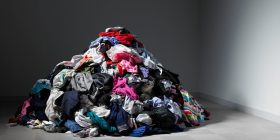planet week blog
The fashion industry is not only one of the largest industries in the planet but also one of its largest polluters. The growing demand for cheaper and faster production of apparel over the last few decades increased exponentially the impact of the industry on the environment. Companies were driven to produce petroleum-based garments, consuming unrenewable resources and creating greenhouse gases (Mitterfelner, 2023), or unethically sourcing natural materials such as cotton causing contamination of soil and clean water used in its production with harmful chemicals. (World Wildlife Fund, n.d.). Post-consumer waste also constitutes one of the industry’s biggest challenges as nearly three-fifths of all clothing ends up in incinerators or landfills within a year of being produced (McKinsey, 2016)
There are practices that can be put in place to mitigate the impact of the industry, disrupting the system itself and replacing the core of how we think of fashion and business.
Current supply chains follow a linear model where natural resources are explored without the conscience to replenish them, and hazardous waste products are left behind without being properly addressed. Despite current efforts, no real change will be made until there is a systemic change about how the industry works as a hole. The circular model is considered to take the problems of linear production and mitigate them by thinking about the hole life cycle of the garments during the initial stage of the design process, evaluating every possibility to make the process more sustainable even after the product reaches consumer, thinking about their impact not only in its production phase but also in its usage phase and its disposal The circular model ensures that products can be re-used, re-purposed or recycled keeping the initial resources in the same circle. (Gwilt,2020).
The change needed to combat the impact of fashion the planet also needs a different systemic outlook on business, besides the l pursuit of profit. Concepts like the triple bottom line (Miller, 2020) stand in alignment with the United Nations Sustainable development goals, to provide an alternative systems where said goals like the one of responsible production and consumption are taken into consideration as much as economic growth factors.
In conclusion, the fashion industry is facing hardships in terms of ethics and sustainable management of resources failing to acknowledge these problems are at its core. Systemic problems need to be addressed, instead of attempting to merely improve the existing system in their current state, an unsustainable approach with insufficient results.
Mitterfellner, O. (2023). Luxury Fashion Brand Management : Unifying Fashion with Sustainability, Taylor & Francis Group, Milton. Available from: ProQuest eBook Central. (Accessed: 6 October 2023)
World Wildlife Fund (n.d.) Cotton. Available at: https://www.worldwildlife.org/industries/cotton (accessed: 5 October 2023)
McKinsey (2016) Refashioning Clothing’s environmental impact. McKinsey Sustainability. Available at: https://www.mckinsey.com/capabilities/sustainability/our-insights/sustainability-blog/refashioning-clothings-environmental-impact(Accessed: 5 October 2023)
Gwilt, Alison. A Practical Guide to Sustainable Fashion. Basics Fashion Design. London: Bloomsbury Visual Arts, 2020. Available at: https://www-bloomsburyfashioncentral-com.arts.idm.oclc.org/encyclopedia?docid=b-9781350067059 (accessed: 5october 2023).
Miller, K. (2020). The Triple Bottom Line: What It Is & Why It’s Important.
University of Wisconsin Sustainable Management. Available at: https://online.hbs.edu/blog/post/what-is-the-triple-bottom-line(accessed: 5 October 2023)
